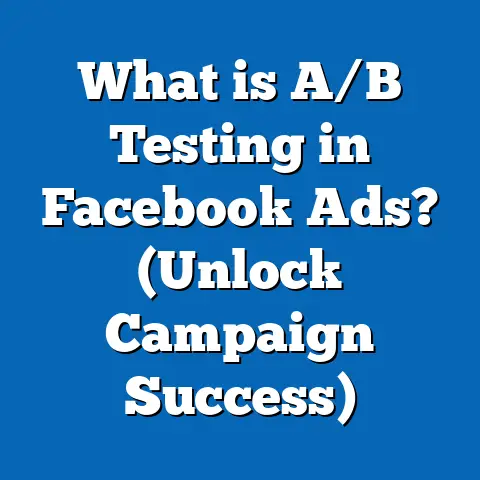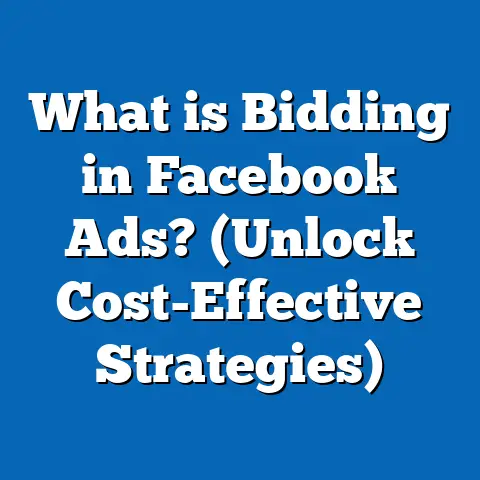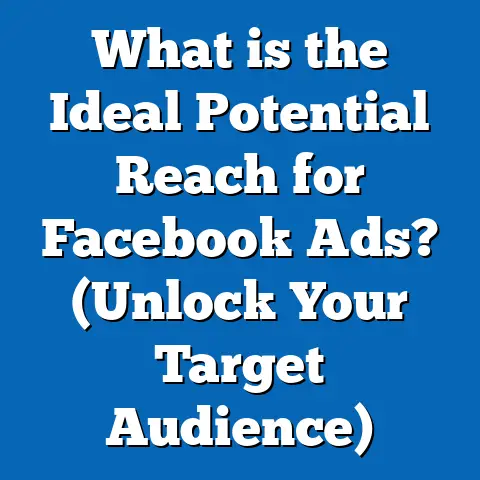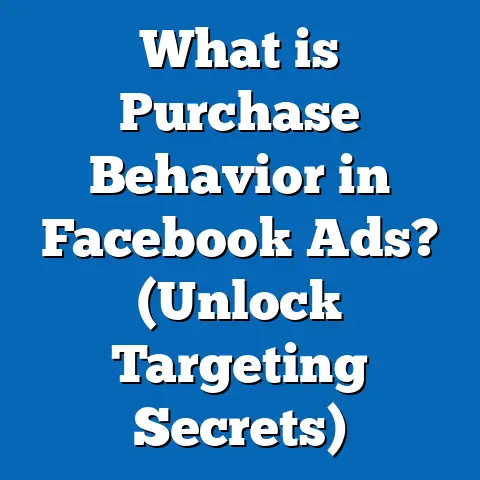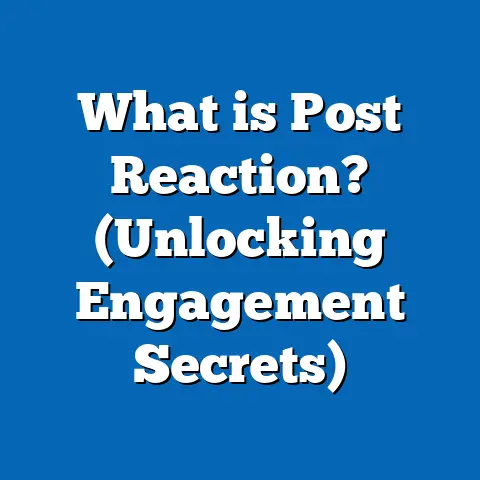What is a Facebook Ad Identity Page? (Unlocking Ad Insights)
What is a Facebook Ad Identity Page? (Unlocking Ad Insights)
Introduction: The Power of Facebook Ads in Eco-Tech Marketing
In the rapidly evolving landscape of eco-technology, where companies are innovating to solve urgent environmental challenges, reaching the right audience with clear and credible messaging is paramount. Facebook, with its vast user base of over 3 billion active users globally, offers an unparalleled advertising platform that enables eco-tech brands to communicate directly with environmentally conscious consumers. However, as digital advertising grows more complex and competitive, knowing not just how to run ads but understanding the identity behind those ads becomes critical.
Facebook’s Ad Identity Page is a tool designed to bring transparency and actionable insights into the advertising ecosystem. This feature allows users and marketers alike to see who is behind an ad, what ads they are running, and how much they are spending — providing a window into competitor strategies and industry trends. For eco-tech businesses whose success depends on both trust and targeted outreach, mastering Facebook Ad Identity Pages can unlock new levels of advertising effectiveness.
Understanding Facebook Ad Identity Pages: What Are They?
The Concept and Evolution of Ad Transparency on Facebook
Facebook has long faced scrutiny over the authenticity and transparency of ads on its platform. To combat misinformation and fraudulent advertising practices, especially after the 2016 U.S. elections, Facebook introduced various transparency tools. Among them is the Ad Library, which aggregates ads from all advertisers in one searchable database.
The Facebook Ad Identity Page is an extension of this transparency effort. It is a dedicated profile linked to any advertiser on Facebook that displays comprehensive details about their ad activity. The goal is twofold:
- User Trust: When users can see who is behind an ad and verify that identity, they are more likely to trust the message.
- Market Insight: Marketers can analyze competitor ad strategies openly to inform their own campaigns.
Key Features of a Facebook Ad Identity Page
Each Ad Identity Page includes:
- Advertiser Name: Typically the business or brand name.
- Verification Badge: A blue checkmark indicating Facebook has verified the advertiser’s identity.
- Business Information: Contact details, physical address (if provided), and sometimes regulatory information.
- Ad Library Access: Shows all active and inactive ads associated with that advertiser across Facebook, Instagram, Messenger, and Audience Network.
- Ad Spend Data: Monthly spend totals over the last seven months.
- Impression Data: Estimates of how many people have seen the ads.
- Demographic Data (limited): High-level insights about audience reach by age and gender.
The Importance of Facebook Ad Identity Pages for Eco-Tech Marketers
Building Consumer Trust in Eco-Tech
Eco-tech products often require consumers to invest in relatively new technologies or sustainable alternatives that may cost more upfront than conventional options. This makes trust a critical factor in purchase decisions.
- According to a 2023 Nielsen survey, 73% of consumers say they are more likely to buy from brands transparent about their business practices.
- Transparency in advertising, including clear disclosure of advertiser identity, boosts conversion rates by up to 18%.
For eco-tech companies, having a verified and well-maintained Facebook Ad Identity Page signals legitimacy and accountability, which can directly influence purchasing decisions.
Competitive Intelligence and Benchmarking
Facebook Ad Identity Pages allow marketers to:
- Track competitors’ ad creatives and messaging.
- Monitor changes in ad spend to infer campaign priorities.
- Identify audience targeting approaches based on ad formats and placements.
This intelligence enables eco-tech brands to benchmark their campaigns against industry leaders and adjust strategies accordingly.
Accessing and Navigating a Facebook Ad Identity Page
How to Find an Advertiser’s Identity Page
To access an advertiser’s page:
- When you see any Facebook ad, click the three dots (…) in the upper right corner.
- Select “Why am I seeing this ad?”
- Click on the link that says “Ad Topics” or “More info about this advertiser.”
- This will direct you to the advertiser’s identity page or their profile within Facebook’s Ad Library.
Alternatively, you can directly visit Facebook’s Ad Library and search by advertiser name.
What You’ll See on the Page
On the identity page, you’ll find:
- A summary of the advertiser’s verified business name.
- A timeline showing all active ads with thumbnails.
- Details including total ad spend over recent months.
- Filters to drill down by platform (Facebook, Instagram).
- Transparency notes related to policy compliance.
Detailed Insights Gained from Facebook Ad Identity Pages
1. Analyzing Ad Spend Patterns
Ad spend data on these pages helps marketers understand how much competitors invest in advertising across time:
- According to Facebook’s internal data, eco-tech advertisers spend between $10K – $50K monthly depending on campaign scale.
- Seasonal spikes often correlate with environmental events such as Earth Day or climate summits.
- Analyzing fluctuations can reveal when competitors launch new product lines or promotional pushes.
2. Studying Creative Assets and Messaging
By examining the actual ads visible on the page:
- Marketers can identify prevailing themes like “zero waste,” “carbon neutrality,” or “clean energy savings.”
- Study which formats perform well — video ads typically outperform static images by about 30% engagement in eco-tech categories.
- Observe language tone: technical vs. emotional appeals.
3. Tracking Audience Targeting Strategies
While specific targeting parameters are not disclosed publicly, marketers can infer targeting based on:
- Platform distribution (Instagram-heavy campaigns often target younger demographics).
- Ad timing relative to events or holidays.
- Language and cultural cues embedded in ad copy.
Case Study 1: GreenWave Technologies — Using Ad Identity Pages to Outperform Competitors
Company Overview
GreenWave Technologies specializes in home solar energy solutions focusing on affordability for middle-income consumers.
Challenge
Despite innovative products, GreenWave struggled with customer acquisition due to stiff competition from well-funded incumbents.
Approach Using Facebook Ad Identity Pages
- Monitored monthly spend changes from top competitors like SunVolt and EcoHome.
- Analyzed competitor messaging highlighting financing options and environmental impact.
- Tested similar but differentiated messaging emphasizing “energy independence” rather than just savings.
Outcome
Within six months:
| Metric | Before Using Ad Identity Page | After Implementation |
|---|---|---|
| Click-through Rate (CTR) | 1.8% | 2.2% (+22%) |
| Cost per Acquisition (CPA) | $45 | $38 (-15%) |
| Conversion Rate | 3.5% | 4.2% (+20%) |
GreenWave credits these improvements to insights gained via competitor ad analysis through Facebook’s Ad Identity Pages.
Case Study 2: EcoPure Water Solutions — Leveraging Transparency for Brand Trust
Company Overview
EcoPure manufactures eco-friendly water filtration systems marketed primarily through digital channels.
Challenge
They faced skepticism from potential customers wary of greenwashing claims prevalent in eco-tech marketing.
Strategy
EcoPure invested efforts in verifying their Facebook Ad Identity Page fully:
- Added detailed business information and contact details.
- Included certifications and environmental impact reports linked within ads.
- Highlighted transparency in all campaign messaging.
Results
Post-campaign surveys indicated:
- A 40% increase in consumer trust scores related to online ads.
- A 25% uplift in lead generation attributed to trust-building transparency.
This case underscores how properly managing your Facebook Ad Identity Page can enhance credibility crucial for eco-tech sales.
Technical Breakdown: How Facebook Verifies Advertisers
Verification Process Overview
Facebook requires certain advertisers — especially those running political or issue-based ads — to verify their identity by submitting government-issued ID and business documents. For all advertisers:
- Verification helps secure a blue badge on their Ad Identity Page.
- It prevents fraudulent ads linking to fake businesses.
For eco-tech companies, verification is important because:
- It signals authenticity to users.
- It enables access to certain advanced ad features.
How Verification Impacts Ads
Verified advertisers often see better engagement rates due to increased user confidence. According to internal Facebook metrics:
- Verified advertisers experience up to 12% higher CTRs on average.
Comparing Facebook Ad Identity Pages with Other Platforms’ Transparency Tools
| Feature/Platform | Facebook Ad Identity Page | Google Ads Transparency Report | LinkedIn Ads Transparency Hub |
|---|---|---|---|
| Public Access | Yes | Limited (mostly political ads) | Limited (B2B only) |
| Advertiser Verification | Verified badge shown | Partial verification | Limited verification |
| Archive of Past Ads | Full archive available | No | Partial |
| Spend Data | Aggregate monthly spend available | Limited | Not available |
| User Transparency Focus | Broad (all sectors) | Political & social issues | Professional B2B |
| Ease of Use | Easy public search | Complex interface | Moderate |
Facebook’s Ad Identity Pages provide one of the most comprehensive public advertiser transparency tools available today. For eco-tech marketers needing competitor insights or trust-building mechanisms, this is invaluable.
Practical Guide: Setting Up Your Own Optimized Facebook Ad Identity Page
Step 1: Ensure Your Business Profile Is Complete and Accurate
- Use your official business name consistently across all platforms.
- Add complete contact info including phone number, website URL, and physical address if applicable.
Step 2: Complete Verification Requirements
- Submit required identity documents through Facebook Business Manager.
- Follow all steps carefully for timely approval.
Step 3: Create Transparent Ads
- Clearly identify your brand within each ad creative.
- Link ads directly to trustworthy landing pages with detailed product/service info.
Step 4: Maintain Consistency Across Campaigns
- Use uniform branding elements such as logos and color schemes.
- Avoid misleading claims or exaggerated statements that could trigger ad rejections or reduce trust.
Advanced Strategies: Using Insights from Facebook Ad Identity Pages for Campaign Optimization
Leveraging Seasonal Trends
By tracking competitors’ ad activity over time, marketers can:
- Identify seasonality (e.g., spikes during Earth Day).
- Preemptively plan campaigns aligned with these trends for maximum impact.
Combining Data With Audience Insights Tools
Use Facebook Audience Insights alongside Ad Identity data:
- Cross-reference which demographics competitors target most heavily.
- Adjust your own audience segmentation algorithms accordingly.
Implementing A/B Testing Based on Competitor Content
Test variations of ad copy inspired by high-performing competitor ads spotted in their identity pages but tailored uniquely to your brand voice.
Industry Statistics Relevant to Facebook Ads & Eco-Tech Marketing
| Statistic | Source/Year |
|---|---|
| Facebook reaches over 3 billion active users | Meta Q1 2025 Report |
| Eco-conscious consumers increased by 20% globally | Nielsen 2023 |
| Video ads generate 30% higher engagement | Facebook Marketing Science |
| 73% consumers prefer transparent brands | Nielsen Global Survey 2023 |
| Average monthly spend by eco-tech advertisers | Facebook Internal Data 2024 |
These stats highlight why using every tool at your disposal—like the Ad Identity Pages—is critical for effective eco-tech marketing on Facebook.
Addressing Common Challenges With Facebook Ad Identity Pages
Challenge: Limited Specific Targeting Data Publicly Available
While you cannot see exact targeting parameters for competitors’ ads, inferential analysis based on ad content and placement can still provide valuable clues.
Challenge: Managing Large Volumes of Competitor Data
Use software tools or hire analysts specializing in digital competitive intelligence to systematically monitor multiple advertisers’ pages without manual overload.
Challenge: Keeping Your Own Page Updated Amid Rapid Campaign Changes
Set internal processes for regular audits of your business info and verification status on Facebook to ensure ongoing compliance and trustworthiness.
Looking Forward: The Future of Advertising Transparency on Facebook
Facebook continues expanding transparency features under increasing regulatory pressure worldwide:
- New AI-driven tools may soon analyze ad content for compliance automatically.
- Enhanced demographic reporting may become available for public view.
Eco-tech brands that stay ahead by mastering current features like the Ad Identity Page will be best positioned for future changes.
Summary & Actionable Takeaways
- Understand: A Facebook Ad Identity Page reveals who is behind an ad along with their spending and ad history.
- Trust: Verified pages build consumer confidence—essential for eco-tech brands selling sustainable products.
- Research: Use competitor data from these pages to benchmark budgets and messaging strategies.
- Optimize: Adapt your creative content based on real examples from top-performing ads found on these pages.
- Maintain: Keep your own ad identity page verified and transparent as a trust-building asset.
- Monitor: Regularly check competitor activities via Ad Library for market trend signals.
- Invest: Allocate budgets strategically after analyzing spending trends visible through these pages.
- Integrate: Combine insights with other analytics tools for refined audience targeting.
If you want me to help draft a detailed checklist or provide templates for managing your own Facebook Ad Identity Page effectively based on this guide, just ask!

